

|
| DEUTSCHLAND | GERMANY |
| Bundesland: Freistaat Sachsen | Saxony |
| Landkreis: Sächsische Schweiz-Osterzgebirge |
Pirna in south-eastern Saxony was first mentioned in a document of 1233. In 1291 it is already mentioned as a town ('civitas'). From 1294 on, Pirna was part of the Kingdom of Bohemia. In 1405 it again became part of the margraviate Meißen which later became the Electorate and later Kingdom of Saxony. In 1634, Pirna was the place of peace negotiations between Saxony and Austria which led to the Peace of Prague in 1635. Like so many other towns, Pirna was looted by Swedish troops during the Thirty Years' War in 1639 and also suffered further in 1706 and 1756 during the Nordic War (see also Leisnig) and the Seven Years' War, respectively. In 1813 French troops occupied the town and Napoleon stayed in Pirna for a few days. The town fortifications and city gates were demolished in 1836.
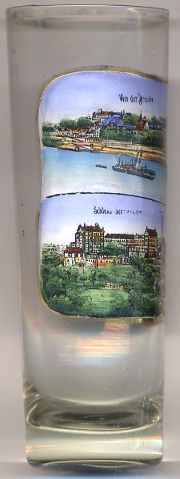
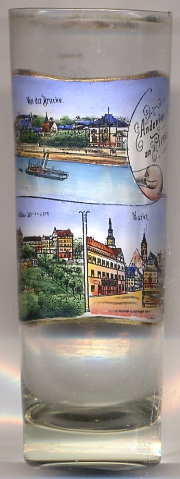
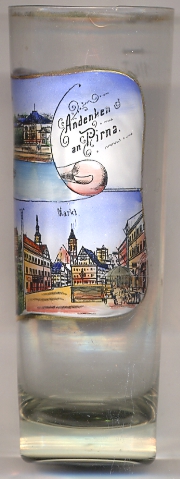 The
The  castle Sonnenstein [left, no. 2977: bottom left picture] above the town was founded around 1200.
The first mention of the castle in a document dates from 1269. The castle was enlarged to become a fortress in 1668–1685 and
in 1735–1737. However, it later lost its importance and lost its status as Saxon fortress in 1764.
In 1811, a mental asylum was opened in the castle but was closed in 1813 by the French who reactivated it as fortress.
The asylum was reopened later and was greatly enlarged between 1890 and 1913.
The Nazis used Sonnenstein for their 'Aktion T4' euthanasia programme. Between 1940 and 1941 about 15,000, mostly mentally
handicapped, people were sent to the gas chamber here; their bodies were cremated in an own crematorium. Both the gas chamber
and the crematorium were removed in 1942. Until 1945 Sonnenstein then served as military hospital. Today it is used for
various purposes such as hotel management school and as seat of administrative bodies.
castle Sonnenstein [left, no. 2977: bottom left picture] above the town was founded around 1200.
The first mention of the castle in a document dates from 1269. The castle was enlarged to become a fortress in 1668–1685 and
in 1735–1737. However, it later lost its importance and lost its status as Saxon fortress in 1764.
In 1811, a mental asylum was opened in the castle but was closed in 1813 by the French who reactivated it as fortress.
The asylum was reopened later and was greatly enlarged between 1890 and 1913.
The Nazis used Sonnenstein for their 'Aktion T4' euthanasia programme. Between 1940 and 1941 about 15,000, mostly mentally
handicapped, people were sent to the gas chamber here; their bodies were cremated in an own crematorium. Both the gas chamber
and the crematorium were removed in 1942. Until 1945 Sonnenstein then served as military hospital. Today it is used for
various purposes such as hotel management school and as seat of administrative bodies.
The  church Sankt Marien [left, no. 2977: bottom left picture: centre background] is still the main church
of the protestant community of Pirna. The oldest church was built during the 13th century. This church was replaced by a
Gothic church of 1466–1478, of which only the church tower remains today. between 1502 and 1546, the present church was built
around the old church which was then removed. This is also one of the reasons why the famous roof of today's church is so high and steep
(the framework of the roof alone has a height of 20 m). The church tower was modified in 1605 and received a baroque roof in the 18th century.
church Sankt Marien [left, no. 2977: bottom left picture: centre background] is still the main church
of the protestant community of Pirna. The oldest church was built during the 13th century. This church was replaced by a
Gothic church of 1466–1478, of which only the church tower remains today. between 1502 and 1546, the present church was built
around the old church which was then removed. This is also one of the reasons why the famous roof of today's church is so high and steep
(the framework of the roof alone has a height of 20 m). The church tower was modified in 1605 and received a baroque roof in the 18th century.
The  town hall [left, no. 2977: bottom left picture: left] was first mentioned in 1396.
The present building was mostly created in the Renaissance period (1555/1556). The Baroque tower was added in 1718.
town hall [left, no. 2977: bottom left picture: left] was first mentioned in 1396.
The present building was mostly created in the Renaissance period (1555/1556). The Baroque tower was added in 1718.
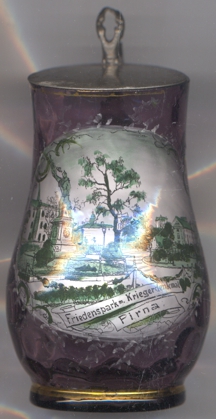
Glass no. 3211 [right] shows a view of
 Friedenspark
Friedenspark
The  Soldiers' monument [right, no. 3211: left]
was erected in 1901 and was meant to commemorate citizens of Pirna who had fallen in the
wars of 1866 (Austro-Prussian War) and 1870/1871 (Franco-Prussian War). The sandstone monument
existed until 1945.
[http://www.denkmalprojekt.org/2014/pirna_denkmal-im-friedenspark_lk-saechsische-schweiz-osterzgebirge_1866_1870_sachs.html]
Soldiers' monument [right, no. 3211: left]
was erected in 1901 and was meant to commemorate citizens of Pirna who had fallen in the
wars of 1866 (Austro-Prussian War) and 1870/1871 (Franco-Prussian War). The sandstone monument
existed until 1945.
[http://www.denkmalprojekt.org/2014/pirna_denkmal-im-friedenspark_lk-saechsische-schweiz-osterzgebirge_1866_1870_sachs.html]
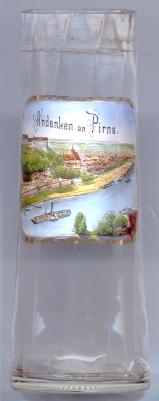
The famous painter Bernardo BELLOTTO (1721–1780, called CANALETTO the younger), painted 11 large views of Pirna, the only small town in his entire work. All paintings are preserved and are parts of the art collections of Dresden, copies can be seen in Houston, Sankt Petersburg and other places.
Johann TETZEL (ca.1465–1519), adversary of the theologian and reformer Martin Luther, was born in Pirna.
Tetzel joined the Dominican monastery of Leipzig in 1489. He later became famous for his sermons
promising indulgence. The common practice of the Catholic church at that time of taking money for indulgence, i.e. granting
relief of purgatorial atonement which is still due for sin after absolution, was one of the major reasons for the reformation
movement of Luther.
[https://de.wikipedia.org/wiki/Pirna]
![[scale]](lineal.jpg)